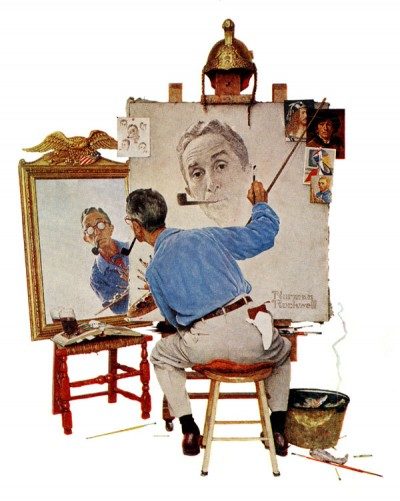“I showed the America I knew and observed to others who might not have noticed.” – Norman Rockwell
 Norman Perceval Rockwell, The Saturday Evening Post’s most famous illustrator, is considered by many to be one of America’s greatest artists. He was a master storyteller via canvas and paint, and his works, capturing the triumphs and foibles of the common man, are as popular today as they were in decades past.
Norman Perceval Rockwell, The Saturday Evening Post’s most famous illustrator, is considered by many to be one of America’s greatest artists. He was a master storyteller via canvas and paint, and his works, capturing the triumphs and foibles of the common man, are as popular today as they were in decades past.
Rockwell’s talent flourished during a period referred to as “The Golden Age of Illustration,” when the nation enjoyed the brilliance of such illustrators as Winslow Homer, J.C. Leyendecker, Maxfield Parrish, N.C. Wyeth, and Ellen Pyle.
Born in New York City on February 3, 1894, Rockwell always wanted to be an illustrator. He transferred to the Chase Art School at the age of 14, and then went on to the National Academy of Design and the Art Students League. There, he was taught by famous artists such as Thomas Fogarty, George Bridgman, and Frank Vincent DuMond. Rockwell’s first major commission came in 1912, when he was just 18, with his first book illustration for Carl H. Claudy’s Tell Me Why: Stories about Mother Nature.
Rockwell later produced works for St. Nicholas Magazine and the Boy Scouts of America’s publication Boys’ Life, of which he later became the art editor. During his three year tenure (1913–1916), he painted several covers, the first, Scout at Ship’s Wheel, appearing on the Boys’ Life September 1913 edition.
Some of Rockwell’s fondest early memories were of summers spent in the country enjoying an adventuresome and carefree existence. His parents took in and cared for boarders, leaving young Rockwell the freedom to spend his days as he wished. Rockwell recalled in his autobiography, “I have no bad memories of my summers in the country,” and remarked that his recollection of this time “all together formed an image of sheer blissfulness.” Many of his experiences during this special time are reflected in his later paintings.
Rockwell’s involvement with The Saturday Evening Post began in 1916. His family had moved to New Rochelle, New York, where a then 21-year-old Rockwell shared a studio with cartoonist Clyde Forsythe, who worked for the Post. Forsythe helped Rockwell submit his first successful cover painting, Mother’s Day Off, to the Post in 1916. Forty-seven years later, Rockwell’s work had appeared 322 times on the cover of The Saturday Evening Post — the last, a portrait of John F. Kennedy, appeared in 1963, a week after the president’s assassination.
Rockwell spent the last 10 years of his career painting about civil rights, poverty, and space exploration for Look magazine. He received the Presidential Medal of Freedom, the United States of America’s highest civilian honor, in 1977 for “vivid and affectionate portraits of our country.”